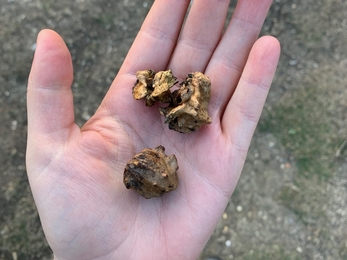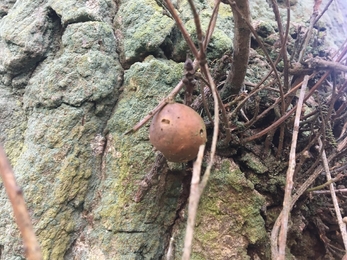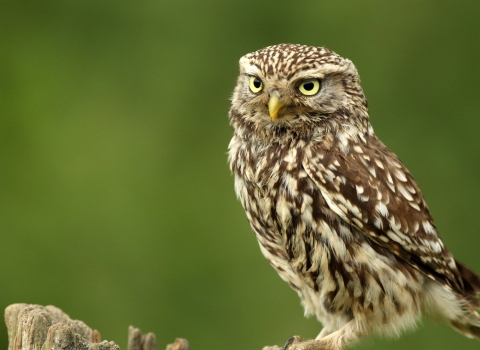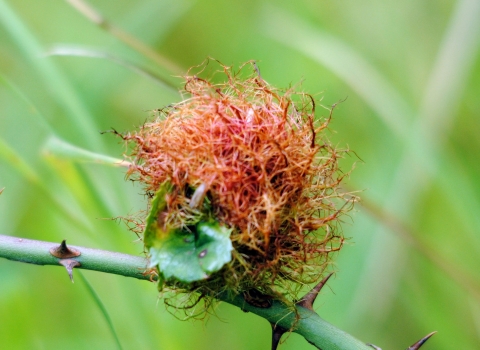With all of us social distancing and many confined, for the most part, to our homes, local walks are becoming a regular part of a lot of daily routines. This is great to see, and hopefully more people will see how crucial nature is to our well being as it comforts us in this very strange time. This is a great time of year to spot some signs of spring while you're out and about, wherever your strolls may take you (though please always follow social distancing guidelines, and follow our reserve access guidelines if you're venturing further). Some of these things are unusual, but not too difficult to find if you keep your eyes open. They might cast a bit of a different light on the world around you.
Three interesting things to find...
Megan Owen
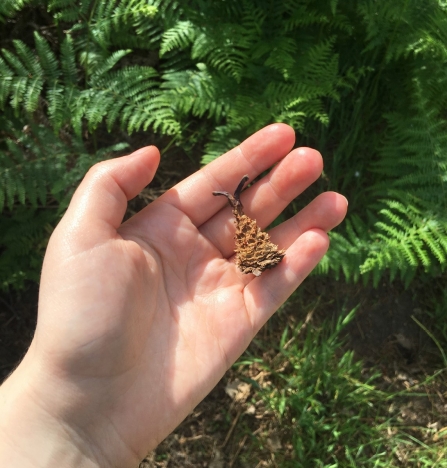
Megan Owen
1. Pine cones that have been eaten by squirrels
Have you ever seen these before? They are the type of of thing that you will start seeing everywhere once you start to notice them, and are more than likely to see in a coniferous woodland (as opposed to a woodland with mostly oak, ash or other trees that drop their leaves in winter). These are pine cones that have been nibbled on by squirrels! Pine cones are a wonderful snack for squirrels, as they contain little seeds located just behind the scales of the pine cone. These seeds are what the squirrels are trying to get to, and will tear back the scales to get them, which leaves us with the leftovers! They eat them a lot like we eat an apple, leaving the core in the middle.
These are made even more fascinating when I tell you that you can actually tell if a squirrel is right or left-handed by the way they have eaten the pine cone. This sounds a bit strange, but it’s true, lots of research has been done into squirrel laterality. In humans being strongly lateralised (right or left handed) improves brain ability, but in squirrels it proves no benefit and those that are ambidextrous are actually better at solving problems! So, who knows why some are left handed?
But, the way to tell which hand they prefer, is to look at the spirals on the pine cone. Squirrels will start at the bottom and work their way upwards in a spiralling motion. If the spirals go anticlockwise then they are left handed, and if they go clockwise then they are right handed! If you look closely at the one pictured, you can see they go anticlockwise, and so we have a left handed squirrel!
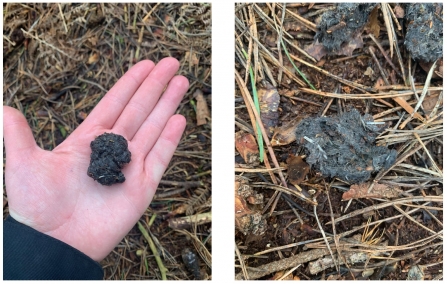
Megan Owen
2. Owl pellets
This one may be a bit harder to spot, until you know what you're looking for and have got your eye in. If you have owls in the area, they should be quite commonly lying around. And once you've found some, you can revisit the same spot and often find them again.
These owl pellets are essentially the leftovers of an owl’s dinner. What they will do is eat their food, and then regurgitate anything they can’t digest, such as bones (if you look closely you can see some small bones in the pictures). This is covered in a grey fluffy substance, which protects their insides as they cough them back up. Nice!
You can tell what owl has made the pellets to a certain extent by what's in them and where you found them. These ones most likely belong to a Tawny owl. They were found in an area of forest that would be an ideal place to live for them, and their distinctive calls have been heard at night in this area. (Fun fact: the ‘twit twoo’ you hear actually comes from two owls speaking to each other: one will say twit and the other will reply twoo!).
3. Oak galls
You have probably seen galls before, whether you know what they are or not. Galls are produced due to the presence of other organisms like tiny specialist wasps growing on, or in, a part of the tree. The wasps will lay their larvae on the oak tree, and secretions from the larvae actually cause a genetic mutation in the tree which makes strange growths appear. These growths offer protection to whatever is growing inside - like a house grown especially for the sneaky little resident. There are actually around 70 different species of gall wasp in the UK, and they will all produce different types of galls.
The knobbly looking acorns in the picture above are knopper galls. The wasps will lay their eggs on the bud of the acorn, or the acorn itself, which causes a knopper gall to develop instead of an acorn and the cup! The larvae will develop inside these galls. These will start off green and eventually turn woody and brown.
The round growth that looks like a marble is called an oak marble gall. This formed when the wasp lays its eggs on the stems of the tree, producing woody balls that are about 25mm in diameter.
These are only two examples of the lots and lots of different types. They all produce different shapes and structures, including things that look like doughnuts, brushes and little sputnik spaceships! Gall wasps are super fascinating, and some will actually have alternating generations from year to year. One generation will consist of sexual males and females, and the next will consist of only asexual females. These different generations will actually produce different types of galls, and sometimes even on different species of tree or plant.
Get out there and take a closer look!
Hopefully this can help you look out for some new things whilst on your daily walk, and maybe impress whoever you are living with! Do share your finds with us on Twitter, Instagram or Facebook.

